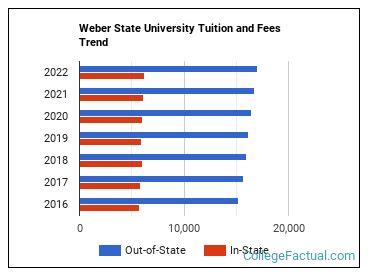Navigating the realm of higher education can be a daunting task, especially when it comes to understanding the financial implications. As you embark on your academic journey at Weber State University, it’s crucial to have a comprehensive understanding of tuition costs to ensure a smooth and financially secure path. This comprehensive guide will delve into the intricacies of tuition at Weber State University, exploring various factors that influence the total amount you’ll need to invest in your education.

Understanding Tuition Costs
At Weber State University, tuition fees vary based on several key factors, including the program you enroll in, residency status, and credit hours taken each semester.
Program Type
The type of program you pursue will significantly impact your tuition expenses. Here’s a snapshot of tuition rates for different programs:
| Program Type | Tuition per Credit Hour |
|---|---|
| Undergraduate Programs | $156.00 |
| Graduate Programs | $252.00 |
| Doctoral Programs | $310.40 |
Residency Status
Residency status plays a crucial role in determining your tuition rates. In-state residents of Utah enjoy significantly lower tuition fees compared to out-of-state students.
| Residency Status | Tuition per Credit Hour |
|---|---|
| Utah Resident | $156.00 |
| Out-of-State Resident | $285.00 |
Credit Hours
The number of credit hours you enroll in each semester directly influences your overall tuition costs. A typical undergraduate student takes 15 credit hours per semester, while graduate students typically take 12 credit hours per semester.
Calculating Total Tuition Costs
To determine your total tuition, simply multiply the tuition per credit hour by the number of credit hours you plan to take each semester. For instance, if you are an in-state undergraduate student taking 15 credit hours, your total tuition for the semester will be:
$156.00 (tuition per credit hour) x 15 (credit hours) = $2,340.00
Additional Costs to Consider
Beyond tuition, there are additional expenses associated with pursuing a degree at Weber State University. These costs may include:
| Expense | Estimated Cost |
|---|---|
| Student Fees | $400-$600 per semester |
| Books and Supplies | $500-$1,000 per semester |
| Housing | $500-$2,000 per month |
| Transportation | $200-$400 per month |
| Food | $200-$400 per month |
Strategies to Reduce Tuition Costs
To minimize the financial burden of higher education, consider implementing the following strategies:
- Apply for Scholarships: Weber State University offers a wide range of scholarships based on academic merit, financial need, and other criteria.
- Take Advantage of Financial Aid: Explore federal, state, and institutional financial aid programs to offset tuition costs.
- Consider Part-Time Enrollment: If possible, reduce the number of credit hours you take each semester to lower your tuition expenses.
- Attend Community College: Complete some of your coursework at a lower-cost community college and transfer the credits to Weber State University.
Common Mistakes to Avoid
To ensure a smooth and financially sound educational experience, avoid the following common mistakes:
- Not Budgeting Properly: Create a realistic budget that accounts for all education-related expenses to prevent financial surprises.
- Overestimating Financial Aid: Don’t rely solely on financial aid to cover the entire cost of education. Explore alternative funding sources to supplement your aid package.
- Ignoring Deadlines: Pay attention to scholarship and financial aid deadlines to avoid missing out on opportunities to reduce tuition costs.
